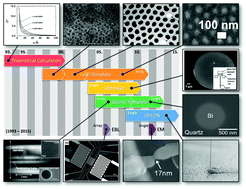Bismuth nanowire thermoelectrics
Abstract
During the past 20 years, the thermoelectric properties of nanostructures such as one-dimensional bismuth (Bi) platforms have prompted the development of a wide variety of nanowire growth methods, aiming to achieve higher energy-conversion efficiency. Most of these methods have demonstrated single-crystal nanowire growth of a quality unmatched in bulk Bi. However, in contrast to the theoretical expectation that Bi nanowires should exhibit high thermoelectric performance, their observed thermoelectric properties have prevented their technological exploitation. Here, we review the current progress in the thermoelectrics of bismuth nanowires, the fundamentals of their advantage and limitation over bulk Bi, and their potential use for enhancing the thermoelectric performance.

- This article is part of the themed collection: The Chemistry of Thermoelectric Materials

 Please wait while we load your content...
Please wait while we load your content...